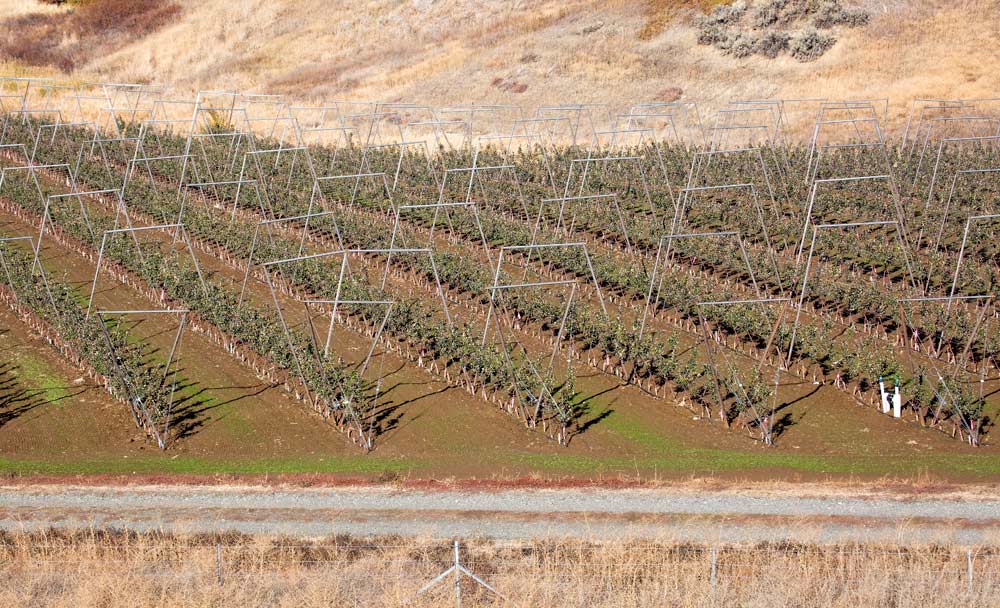
A new tree insurance program in development aims to help growers protect their investment in orchards, since costs have risen dramatically with high-density systems like this V-trellis planting in Kittitas County, Washington. (TJ Mullinax/Good Fruit Grower)
USApple and a team of crop insurance experts are developing a new insurance product that would allow growers to protect the investment in their trees, now that high-density systems have raised the costs of new orchards significantly.
“In the last 10 or 15 years, the huge capital exposure from the cost of trees really jumped up on people,” said Mark Seetin, director of regulatory affairs for USApple. The group’s risk management task force pushed the idea. “Even though the loss of high numbers of trees is quite rare, it’s devastating for the producer when it happens.”
Specifics about the rates and coverage levels are still being worked out to create a program that will meet growers’ needs and be financially stable, said Ray Prewett, a consultant for insurance firm AgriLogic, who is leading the effort to develop the policy. “Insurance coverage would be on a tree by tree basis and the amount of coverage will depend on tree age and variety,” he said. “All of the weather-related perils that are in crop insurance will be part of this tree policy. Drought, excess moisture, winter injury, wind and hail are the more common.”
If approved, it would become part of the U.S. Department of Agriculture’s crop insurance program and be available to growers in Washington, Michigan, New York, Pennsylvania, Virginia, Oregon and North Carolina through their local insurance providers. AgriLogic just has the funding to develop the policy, not the sole right to administer it.
Tree insurance is a bit of an outlier for the USDA’s Risk Management Agency but there are already tree policies in place for citrus, pecan and macadamia nut growers, said Prewett, who worked on the development of citrus tree policies while working as the president of Texas Citrus Mutual.
The policy may also include the option to take out supplemental insurance to protect against loss to fire blight, provided that the grower has taken all the best management practices to manage the disease.
In the citrus industry, growers have sought to include citrus greening in tree insurance policies because they have no tools to control or manage it, Prewett said, but it won’t work because the disease is becoming so common and destructive that the premium rates would have to be unreasonably high. Hopefully, they can find a way to make a policy work for fire blight in apples, he said.
Developing a new policy involves weighing the risks of loss, the value of different varieties at different ages, and what rates growers would be willing to pay for coverage. The policy will also have to meet the USDA guidelines to ensure that the program is fair and won’t lose money, since the federal government covers a share of the premiums.
“We’re trying to make the program as flexible and targeted as possible, within the rules,” Prewett said, citing a common rule for crop production policies that farmers who want to insure 1 acre have to insure all the acres in a given county. “We have more flexibility in specialty crops on that, but the general rule is that you don’t want to insure a house that is already on fire or take insurance on only your most vulnerable.”
Rates will likely be higher on young trees, which tend to be at greater risk, he said. And he expects the policy will use several categories for variety value, similar to the apple fruit policy.
Seetin points to the success of that apple fruit policy to show how risk management is valuable to growers. About 72 percent of U.S. apple production is covered by the optional policy, he said.
Prewett said that he plans to meet with growers across the country this winter to get a firmer idea of what growers want and would be willing to pay. Once he’s confident they are striking a good balance on premiums and coverage levels, the proposed policy will go to the Federal Crop Insurance Commission for review. Seetin said he’s optimistic about the policy, but even if all goes well, it probably won’t be available for growers until at least 2020. •
– by Kate Prengaman






Leave A Comment